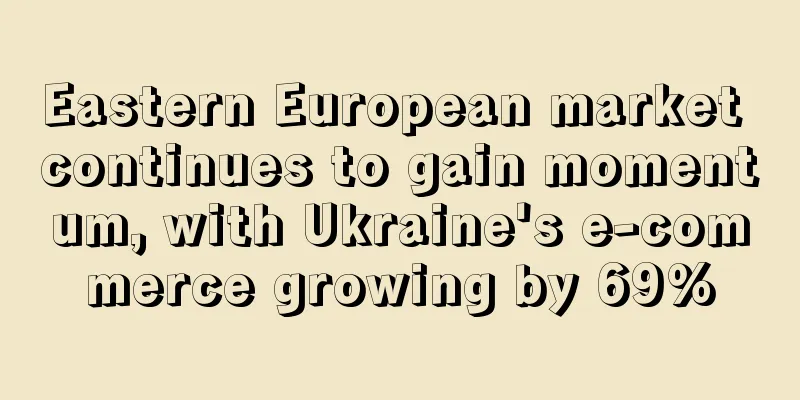Eastern European market continues to gain momentum, with Ukraine's e-commerce growing by 69%

|
European e-commerce is booming. In addition to the more developed Western Europe, Eastern Europe is also making continuous efforts. Ukraine is one of the representatives. Ukraine is an Eastern European country with a population of more than 42 million. Its e-commerce growth rate ranks second in the whole of Europe.
According to foreign media statistics, from the beginning of 2019 to date, the number of e-commerce sellers in Ukraine has increased by 14%, the average income of online sellers has increased by 1.5 times, and the overall profit has increased by 69%.
Moreover, in 2020, Ukraine's e-commerce turnover accounted for 8% of total retail sales, a year-on-year increase of 36%, ranking first in the growth rate of all Eastern European countries. Although the e-commerce market share is still not high, it is also in a state of rapid growth.
Among them, Dnipro and Ukraine's capital Kiev saw the most significant growth in e-commerce revenue, with growth rates of 72% and 70% respectively.
Moreover, according to the data, more than half of Ukraine's total e-commerce revenue comes from the following five cities: Odessa, Kiev, Dnipro, Lviv and Kharkiv. The average income of online sellers in Odessa is 16% higher than that in Kiev.
During the pandemic, consumer habits throughout Europe are changing, and food retail is the best example of this trend. In 2020, Ukraine's e-commerce food retail sales grew by 107% year-on-year, and more than half of the sellers said that free delivery, cargo tracking, and free returns have become the most important e-commerce services. Market research also shows that more and more consumers are willing to join the ranks of online shopping.
The growth rate is also reflected in the online shopping penetration rate. In the third quarter of last year, the online shopping rate in Ukraine reached 33%. So far, the online shopping penetration rate has reached 42%. Market trends also show that this figure will continue to increase in the future.
However, local consumers currently still prefer the local e-commerce platform Rozetka. Amazon and AliExpress also have a market, but their share is still relatively small.
Judging from the preferences of local consumers, the product categories with the highest sales volume are clothing, home appliances and cosmetics. Among them, price and local language are the deciding factors for their purchases.
According to forecasts, in the next five years, the scale of Ukraine's e-commerce will continue to grow, and its share in the entire retail industry will gradually increase. Europe Ukraine |
<<: Pinterest loses 24 million users as global lockdowns and physical stores reopen
>>: Sad! Amazon sellers were banned due to malicious complaints
Recommend
What is Kohl's? Kohl's Review, Features
Kohl's , founded by the Kohl family in Milwau...
South Korea's express parcel volume exceeds 3 billion in 2020
South Korea is the fifth largest e-commerce marke...
More than 2,000 people attended and the sales were huge! This cross-border e-commerce event was a blast
It finally comes out after much anticipation! The...
What is Kuaibao? Kuaibao Review, Features
Shenzhen Kuaibao Holding Group Co., Ltd. was estab...
Indonesian e-commerce company Bukalapak raises $234 million
Indonesian e-commerce company Bukalapak has raise...
The judgment is invalid! Big sellers get back the frozen funds on the platform
Chinese sellers who were branded as violators and...
What is rollandhill? rollandhill Review, Features
rollandhill is a design-conscious furniture and li...
Serial critical hits! Amazon people are struggling to find a new way out, but independent site sellers are laughing...
Amazon has a variety of problems, and independent...
51 required courses on Amazon operations, original price 499, limited delivery →
It's time to give out benefits again! Previou...
What is Puji Intellectual Property? Puji Intellectual Property Review, Features
Puji Intellectual Property is a service organizati...
After Southeast Asia, will Shopee create a legend in the Latin American market?
In June, Shopee opened online sales websites and ...
Breaking news! America's largest warehouse district is full
The latest news is that the Inland Empire, the la...
Yoshihide Suga said: The state of emergency in Tokyo, Japan will be extended for two weeks
According to the Jiji Press, Japan reported 888 n...
What is Eagles Technology? Eagles Technology Review, Features
Eaglethink Technology was established in 2015 and ...
What is Dolphin Japan Warehouse? Dolphin Japan Warehouse Review, Features
Dolphin Japan Warehousing Center is a product of ...









